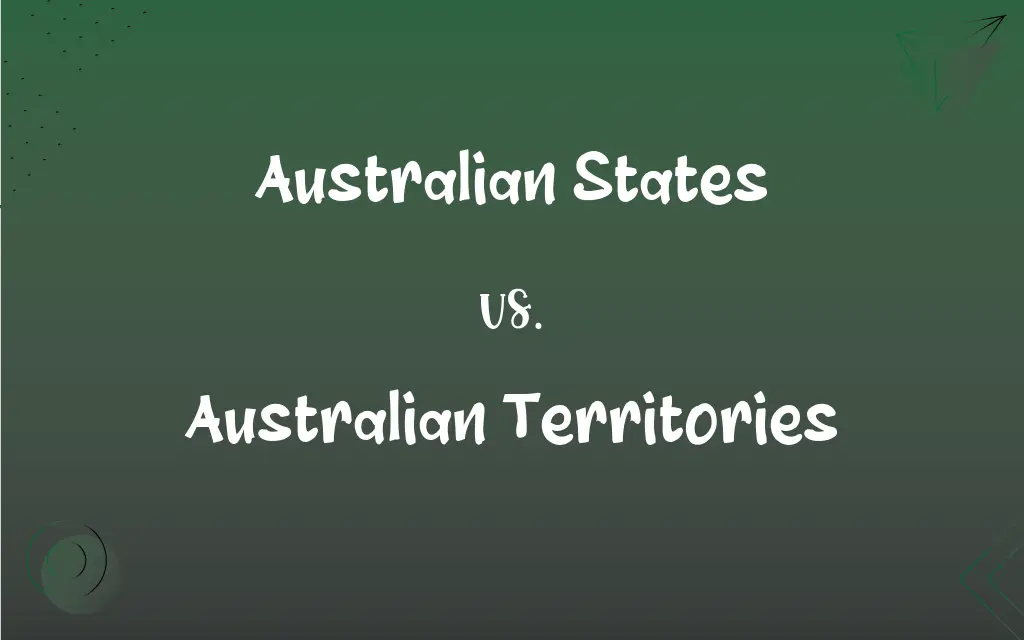Australian States vs. Australian Territories: What's the Difference?
Edited by Aimie Carlson || By Harlon Moss || Updated on October 12, 2023
Australian states have their own government and constitution, while Australian territories are governed by the Australian federal government. Each holds different governmental powers.

Key Differences
When examining Australian states, they signify self-governing regions under the Australian constitution. Each of these Australian states possesses its own government that legislates on most matters and has its own constitution. Whereas, Australian territories don’t have the same degree of self-governance, as they are administratively legislated by the Australian federal government to a larger extent, and some do not have their own constitution.
Observing the historical context, Australian states were original colonies that joined the federation, constituting the Commonwealth of Australia in 1901. In contrast, Australian territories were acquired or established after this federation and, thus, were not part of the original constitution. Both Australian states and Australian territories have their own specific historical evolution which led to their current governance structures.
Pertaining to the representation in the Senate, Australian states have a higher level of representation. Each state, irrespective of its population size, is represented by twelve senators. Australian territories, however, do not have equal representation, as they have only two senators each. Therefore, the Australian states and Australian territories have different levels of influence in the federal legislative process.
Regarding legal authority, Australian states operate with substantial independence in legislating on many issues, from healthcare to education, underpinned by their own constitutions. Australian territories, conversely, have legislation that can be overridden by the federal government, thus granting them less legislative independence compared to Australian states. Both Australian states and territories are subject to different extents of federal oversight.
Focusing on geographic and demographic aspects, Australian states generally have larger populations and land masses compared to Australian territories. Although there are exceptions in terms of land mass size, Australian territories are generally less populated. Both Australian states and territories encompass diverse geographical features, climates, and demography.
ADVERTISEMENT
Comparison Chart
Governance
Have their own government and constitution.
Governed more directly by the federal government.
Historical Origin
Original colonies in the federation of 1901.
Acquired or established after federation.
Senate Representation
Twelve senators each, regardless of population.
Typically two senators each.
Legislative Authority
Extensive legislative power and autonomy.
Less legislative autonomy.
Population & Geography
Generally larger in population and geography.
Tend to be smaller in population and geography.
ADVERTISEMENT
Australian States and Australian Territories Definitions
Australian States
Australian states possess the authority to create and implement their own legislation.
Australian states can legislate on matters like criminal law and transportation independently.
Australian Territories
Australian territories are areas that were acquired after the federation of Australia in 1901.
Australian territories, such as the Northern Territory, were established subsequent to the initial federation.
Australian States
Australian states have significant representation in the Australian federal parliament.
Australian states have equal and substantial representation in the Senate, regardless of their size or population.
Australian Territories
Australian territories usually house smaller populations and can be geographically varied.
Australian territories, like the Australian Capital Territory, generally have smaller populations than most states.
Australian States
Australian states are sovereign, governing entities with defined geographic boundaries.
Each Australian state manages its own public health and education systems.
Australian Territories
Australian territories fall more directly under federal jurisdiction and governance.
Laws in Australian territories can be modified or nullified by the federal government.
Australian States
Australian states are individual entities that united to form the Commonwealth of Australia.
The Australian states came together in 1901 to form a federative union.
Australian Territories
Australian territories have limited representation in the Australian Senate compared to states.
Australian territories typically send fewer representatives to the Senate than the states do.
Australian States
Australian states encompass large land masses and are generally populous.
The Australian states, like Queensland and Victoria, boast diverse landscapes and substantial populations.
Australian Territories
Australian territories might not possess their own independent government or constitution.
Unlike states, some Australian territories lack a comprehensive independent legal and governmental structure.
FAQs
How many Australian states are there?
There are six Australian states: New South Wales, Queensland, South Australia, Tasmania, Victoria, and Western Australia.
What constitutes Australian states?
Australian states are self-governing regions with their own constitutions and governments.
What is the main legislative difference between the two?
Australian states have broader legislative authority, while territories can be overridden by federal law.
Do both have their own constitutions?
Australian states have their own constitutions, while not all territories do.
What is the capital of an Australian state?
Each Australian state has its own capital, e.g., Sydney is the capital of New South Wales.
Can states interfere in territory governance?
No, states do not have the authority to interfere in the governance of territories.
Who is responsible for healthcare in states and territories?
Both Australian states and territories are responsible for managing their respective healthcare systems.
How are tax revenues managed in states and territories?
Both states and territories manage their tax revenues but may receive differing levels of federal funding.
How did Australian states form?
Australian states originated from colonies that joined together in the federation of 1901.
Is there a difference in court systems?
Yes, Australian states and territories can have different court systems and jurisdictional structures.
How are senators chosen in states and territories?
Senators are elected by the public, but states and territories have different numbers of representatives.
Can territories become states?
Theoretically, territories can become states through constitutional alteration and negotiation.
How can one distinguish between a territory and state?
Key distinctions include governance, legislative autonomy, historical formation, and Senate representation.
How are Australian territories governed?
Australian territories are generally more directly governed by the Australian federal government.
Can Australian territories create their own laws?
Yes, territories can create their own laws, but they may be subject to federal override.
Are the populations of territories generally smaller?
Yes, typically, Australian territories have smaller populations compared to states.
How are leaders chosen in Australian states?
Leaders (Premiers) in Australian states are usually the head of the party with the most legislative seats.
What are some examples of Australian territories?
The Northern Territory and the Australian Capital Territory are examples of Australian territories.
Who governs the Australian territories?
Australian territories are generally governed by a federal appointed administrator or a self-government structure.
Do all territories and states have the same rights?
No, states generally possess more autonomous rights compared to territories.
About Author
Written by
Harlon MossHarlon is a seasoned quality moderator and accomplished content writer for Difference Wiki. An alumnus of the prestigious University of California, he earned his degree in Computer Science. Leveraging his academic background, Harlon brings a meticulous and informed perspective to his work, ensuring content accuracy and excellence.
Edited by
Aimie CarlsonAimie Carlson, holding a master's degree in English literature, is a fervent English language enthusiast. She lends her writing talents to Difference Wiki, a prominent website that specializes in comparisons, offering readers insightful analyses that both captivate and inform.































































